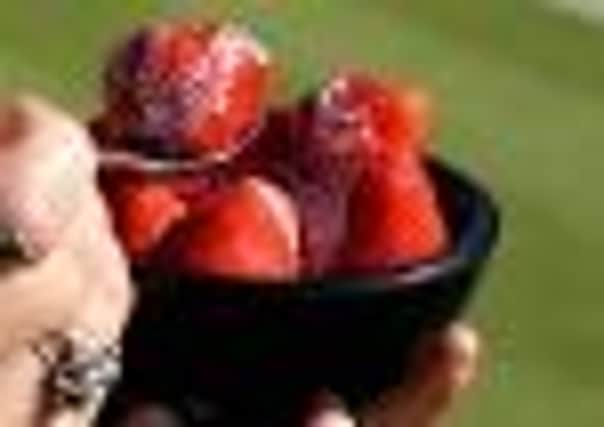Rain may stop play... but it hasn’t hit the Wimbledon strawberries


YES, it’s the time of year when those lucky enough to have tickets for Wimbledon will look forward to enjoying one of those small punnets of overpriced strawberries and cream – something we associate as being a quintessential part of English summer.
However, we’re sadly missing the “summer” part of the picture, and tennis lovers marching towards the All England Club in SW19 are armed to the hilt with stout footwear, fleeces, cagoules and brollies.
Advertisement
Hide AdAdvertisement
Hide AdStill, the strawberry stands will do brisk business – maybe even more so when rain stops play and frustrated fans wander aimlessly, looking for satisfaction for the taste buds where there may be little to sate their hunger for top-class tennis.
Around 28,000kg of English strawberries are expected to be eaten during Wimbledon fortnight, and it’s simply not on for the many vendors at the club to run out of supplies – whatever the weather and however much the record rainfall may have affected crops.
Tucking in to a bowl of our favourite summer fruit is to indulge ourselves as the Romans did as far back as 200BC. In medieval Britain newlyweds enjoyed a soup made of strawberries, borage and soured cream for their wedding breakfast, in the belief that this concoction was an aphrodisiac. The heart-shaped fruit has been seen down the ages as a symbol of purity, passion and healing.
Although still seen as part and parcel of summer, the days are long gone when we gorged on strawberries during a short June-August season. British strawberries now have a six-month season, thanks to more acreage being given over to them and the use of polytunnels by many producers. So today they are more of an everyday fruit, and a mere five provide more vitamin C than a whole orange.
Advertisement
Hide AdAdvertisement
Hide AdAt the peak of the season, all strawberries sold in the UK are grown here and the market is growing by 10-15 per cent a year. Outside the April-October season, imports from Spain, Morocco, Israel and Egypt are brought in to supply huge consumer demand, and frozen imports from China also bridge the gap.
As we approach the peak of British strawberry growing, producers are having their most trying season in years due to the wet and dull weather, with growth currently running two and a half weeks late and volume at least 25 per cent behind 2011, according to British Summer Fruits (BSF), the organisation that represents growers.
Laurence Olins, of BSF, describes the difficulties presented by the weather so far this season as “challenging” but he’s optimistic and says polytunnels – so loathed by some environmentalists – have been a godsend.
“The weather has had a smoothing effect on production levels,” says Olins. “So rather than creating peaks of production there will now be a more steady supply of fruit throughout the summer. Twenty years ago the crop would have been decimated by the inclement weather over the past few months but thanks to two decades of investment in protective covers we have a thriving British soft fruit industry – one of the success stories of British horticulture. Berry growers are particularly resilient and have been working very hard to ensure a reliable supply of good-quality strawberries to retailers.”
So rest easy – something red, juicy and British will still be plentiful, even if summer is not.